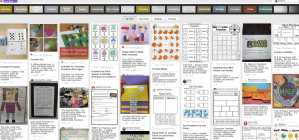This week, we’re learning about fractions and rational numbers, and how to teach these concepts to elementary-aged students. Our textbook and companion website provided instruction, but I decided to seek out additional information. In today’s world, there’s a wealth of information available to teachers and the click of a finger. Teachers share lesson plans, share stories, share what works and what doesn’t. There’s more information than we could ever process, much of it for free. This is a good thing, right?
You would think that this information is a blessing. Sometimes, though, the wealth of information becomes overwhelming. It seems like there’s always another method, another opinion, another strategy. This is often referred to as the Paradox of Choice. Essentially, we get anxiety when there are too many options and regret whichever option we end up choosing because we think that there could also be something better out there. For example, when I searched Pinterest for “fractions”, a seemingly infinite number of responses were provided, as well as suggestions – did I want to also search for adding fractions? Teaching fractions to 1st graders? Improper fractions?
What if I picked a strategy that doesn’t work for my students? These thoughts and more often race through my mind while doing online research. As I’ve continued pursuing my elementary education degree, I’ve had to come up with some basic rules to deal with this anxiety…
1. Understand the concepts you want to teach. If I want to search for lessons to teach my students fractions, I need to have a solid foundational knowledge of what a reciprocal is and how the invert-and-multiply rule works.
2. Understand your students. If I know that my group is a particularly hands-on bunch, I’ll search for “teaching fractions using manipulatives” to lessen the overwhelming amount of information coming back to me.
3. Don’t spend more than an hour searching online. Clicking on one link leads to another link leads to another link leads to another. Suddenly you’ve spent five hours online doing research and haven’t actually started writing your lesson. Too much information is just going to overwhelm your students anyway.
4. Don’t substitute the Internet for your brain. Personally, I have to really force myself to hunker down and get creative when creating lesson plans. Often I find that browsing the Internet for resources and ideas helps get my creativity going so that I can adapt what I find online for my own lessons. Other times, I find that it only hinders my fully-capable brain of creating a lesson on my own. And it’s the 100% self-created lessons that I’m the most proud of.
That’s it! It’s not ground-breaking, but it helps me fight the paradox of choice. I’m obviously in the very, very early stages of my teaching career, so I would love any insight others have on using online resources for lesson planning. Good? Bad? Overwhelmed too? Let me know!
